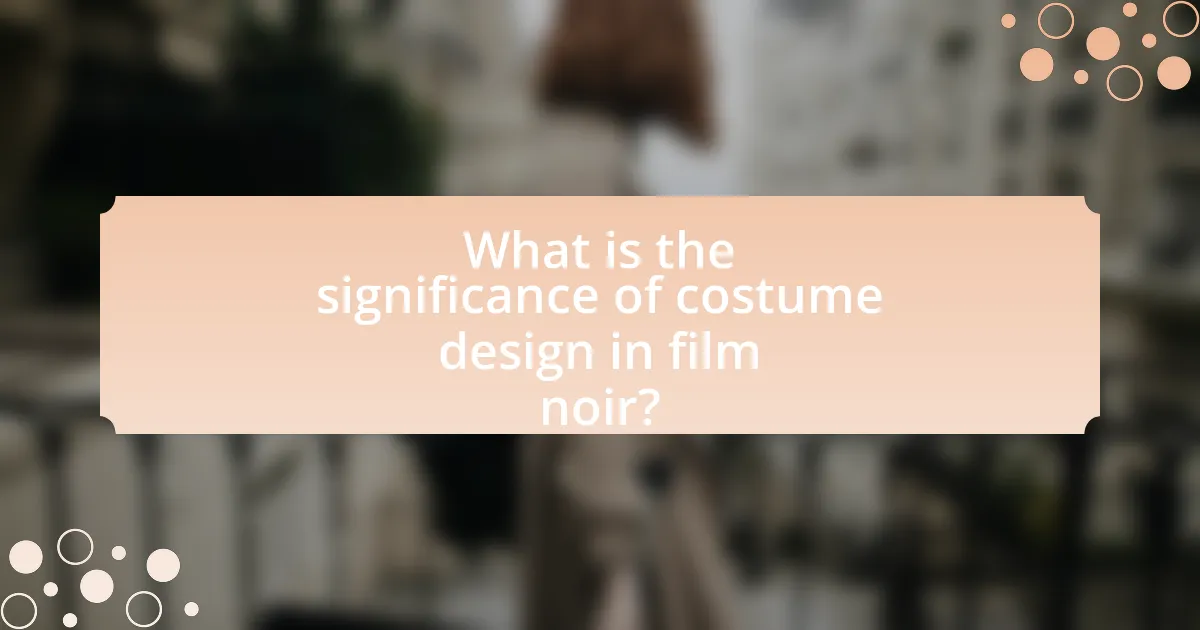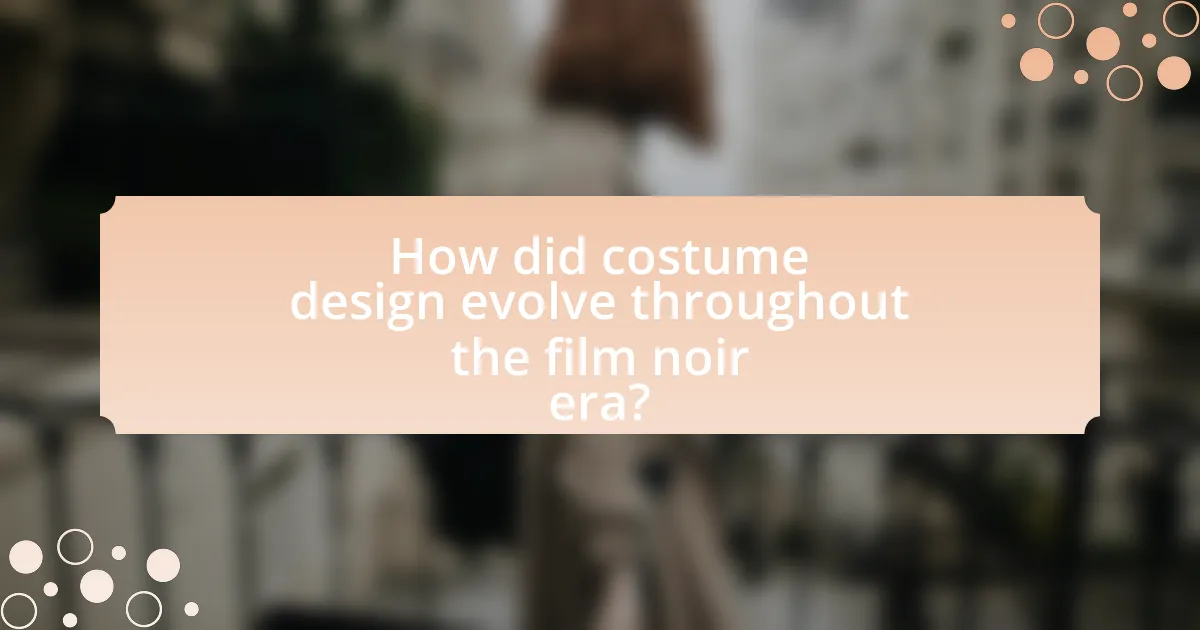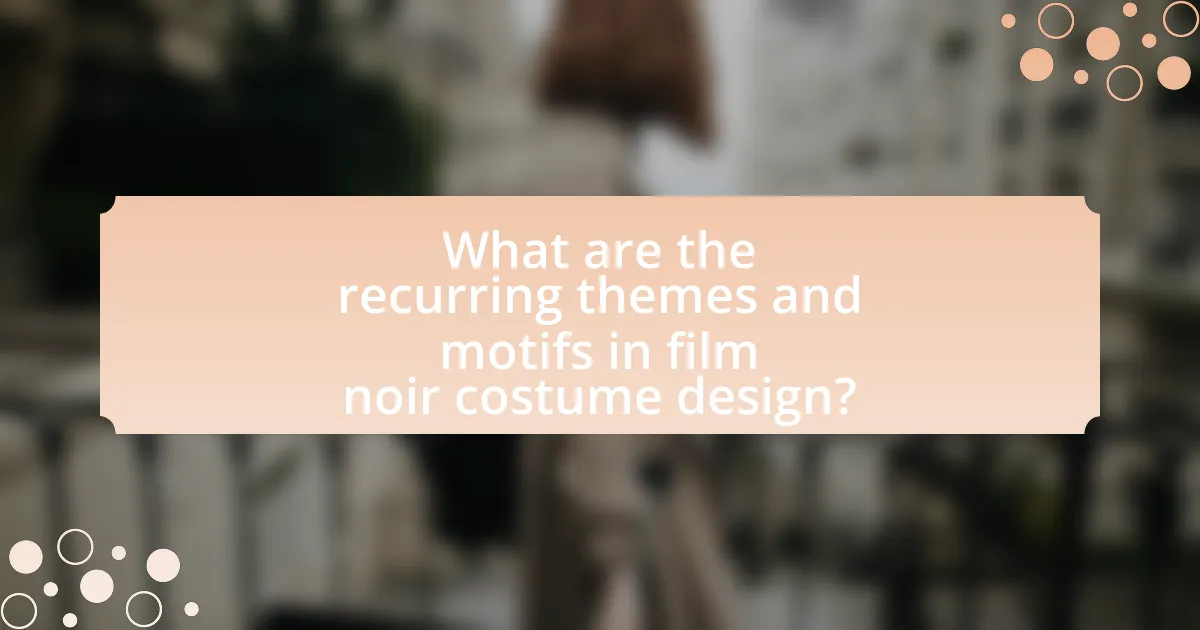The article examines the evolution of costume design in film noir, highlighting its significance in conveying character traits, themes, and the overall mood of the genre. It discusses how dark colors, sharp silhouettes, and period-specific attire contribute to the psychological tension and moral ambiguity characteristic of film noir narratives. Key elements such as the portrayal of archetypal characters, the influence of historical contexts, and the role of iconic designers are analyzed to illustrate how costume design has shaped the visual language of film noir. Additionally, the article explores the impact of societal changes on character representation and the techniques used to enhance dramatic effects through costumes.

What is the significance of costume design in film noir?
Costume design in film noir is significant because it visually conveys character traits, themes, and the overall mood of the narrative. The use of dark colors, sharp silhouettes, and period-specific attire helps to establish the psychological tension and moral ambiguity characteristic of the genre. For instance, the femme fatale is often dressed in form-fitting, glamorous outfits that symbolize both allure and danger, while the male protagonists typically wear trench coats and fedora hats, reinforcing their roles as troubled anti-heroes. This visual language not only enhances storytelling but also reflects the socio-cultural context of the 1940s and 1950s, where post-war disillusionment and urban anxiety were prevalent.
How did costume design contribute to the overall aesthetic of film noir?
Costume design significantly contributed to the overall aesthetic of film noir by utilizing dark, moody colors and sharp silhouettes that reflected the genre’s themes of mystery and moral ambiguity. The use of tailored suits for male characters and glamorous, form-fitting dresses for female characters created a visual contrast that emphasized the tension and complexity of their relationships. For instance, the iconic trench coats and fedoras worn by protagonists not only established a sense of style but also symbolized their roles as anti-heroes navigating a corrupt world. Additionally, the interplay of light and shadow on these costumes enhanced the visual storytelling, reinforcing the genre’s characteristic chiaroscuro effect. This deliberate choice in costume design helped to create an immersive atmosphere that defined film noir, making it instantly recognizable and influential in cinematic history.
What elements define the visual style of film noir costumes?
The visual style of film noir costumes is defined by a combination of dark color palettes, sharp contrasts, and tailored silhouettes. Dark colors, particularly black, gray, and deep hues, create a moody atmosphere that reflects the genre’s themes of moral ambiguity and danger. Sharp contrasts, often achieved through the use of light and shadow, enhance the dramatic effect of the costumes, emphasizing the characters’ psychological states. Tailored silhouettes, characterized by structured lines and fitted designs, convey a sense of sophistication and tension, aligning with the archetypal roles of femme fatales and hard-boiled detectives. This combination of elements effectively captures the essence of film noir, as seen in classic films like “Double Indemnity” and “The Maltese Falcon,” where costume design plays a crucial role in storytelling and character development.
How do colors and fabrics influence the mood in film noir?
Colors and fabrics significantly influence the mood in film noir by creating a sense of tension and emotional depth. Dark colors, such as black and deep shades of gray, evoke feelings of mystery and danger, while contrasting lighter colors can highlight vulnerability or innocence. Fabrics like silk and wool contribute to the texture and visual richness of costumes, enhancing the overall atmosphere. For instance, the use of glossy fabrics can reflect light in a way that emphasizes the stark contrasts typical of noir cinematography, reinforcing themes of duality and moral ambiguity. Historical examples include the iconic use of trench coats and fedoras, which not only define characters but also symbolize the pervasive sense of paranoia and existential dread inherent in the genre.
Why is the evolution of costume design important in understanding film noir?
The evolution of costume design is crucial for understanding film noir because it reflects the genre’s thematic complexities and character archetypes. Costume design in film noir evolved from the glamorous styles of the 1940s to more subdued and practical attire, mirroring the psychological and moral ambiguity of the narratives. For instance, the transition from the elegant dresses of femme fatales to more understated clothing illustrates the shift in female representation and the growing emphasis on realism. This evolution also highlights the use of shadows and silhouettes, which are integral to the visual style of film noir, enhancing the mood and reinforcing the themes of deception and duality. The specific choices in costume design, such as the use of dark colors and sharp lines, serve to visually communicate the tension and conflict inherent in the genre, making it a vital aspect of film noir’s identity.
What historical contexts influenced costume design in film noir?
Costume design in film noir was significantly influenced by the socio-political climate of the 1940s and 1950s, particularly the aftermath of World War II and the rise of urbanization. The war led to a sense of disillusionment and moral ambiguity, which was reflected in the dark, stylish clothing worn by characters, often featuring sharp lines and contrasting colors. Additionally, the economic constraints of the time resulted in the use of more practical and accessible materials, which shaped the aesthetic of noir costumes. The influence of German Expressionism, characterized by its emphasis on shadows and stark contrasts, also played a crucial role in defining the visual style of film noir, impacting how costumes were designed to enhance the overall mood and themes of the genre.
How did societal changes impact the portrayal of characters through costumes?
Societal changes significantly influenced the portrayal of characters through costumes in film noir by reflecting contemporary cultural attitudes and norms. For instance, the rise of feminism in the 1940s and 1950s led to the depiction of strong female characters, which was mirrored in their costumes that combined both allure and empowerment, such as tailored suits and bold accessories. Additionally, the post-World War II era saw a shift towards more sophisticated and complex male characters, often dressed in sharp suits that symbolized power and moral ambiguity, aligning with the societal fascination with the anti-hero archetype. These costume choices not only conveyed character traits but also served as visual commentary on the evolving social landscape, illustrating how attire can encapsulate broader societal themes and changes.

How did costume design evolve throughout the film noir era?
Costume design in the film noir era evolved from the glamorous styles of the 1940s to more subdued, practical attire by the 1950s. Initially, costumes emphasized elegance and sophistication, featuring tailored suits for men and glamorous dresses for women, reflecting the post-war desire for escapism and luxury. As the genre progressed, the focus shifted towards darker, more utilitarian clothing that mirrored the themes of moral ambiguity and existential dread prevalent in film noir narratives. This transition is evidenced by the use of muted colors, simpler silhouettes, and an emphasis on character-driven attire, which aligned with the gritty realism of the stories being told. The evolution of costume design thus paralleled the changing societal attitudes and cinematic trends, marking a significant shift in visual storytelling within the genre.
What were the key milestones in the evolution of costume design in film noir?
The key milestones in the evolution of costume design in film noir include the introduction of femme fatale archetypes in the 1940s, the use of contrasting light and shadow to enhance character traits, and the influence of post-war fashion trends. The femme fatale, exemplified by characters in films like “Double Indemnity” (1944), showcased glamorous yet dangerous attire, which became a defining feature of the genre. Additionally, costume designers utilized chiaroscuro techniques to reflect the moral ambiguity of characters, as seen in “The Maltese Falcon” (1941), where clothing choices visually represented inner conflict. The post-war era also brought a shift towards more practical and subdued styles, influenced by the changing societal norms and economic conditions, which can be observed in films like “Out of the Past” (1947). These milestones collectively shaped the distinctive aesthetic of film noir, emphasizing themes of seduction, danger, and existential despair.
Which films marked significant changes in costume design trends?
“Film Noir” marked significant changes in costume design trends, particularly through films like “Double Indemnity” (1944) and “The Maltese Falcon” (1941). “Double Indemnity” introduced a more sensual and form-fitting style for female characters, emphasizing the femme fatale archetype, while “The Maltese Falcon” showcased a more tailored and sophisticated look for male characters, influencing the portrayal of masculinity in film. These films set new standards in costume design, reflecting the darker themes and complex characters typical of the genre, and their influence can be seen in subsequent film styles and fashion trends.
How did the introduction of new materials and techniques affect costume design?
The introduction of new materials and techniques significantly transformed costume design by allowing for greater creativity and realism in film noir. Innovations such as synthetic fabrics and advanced tailoring methods enabled designers to create more intricate and varied silhouettes that enhanced the visual storytelling of the genre. For instance, the use of materials like rayon and nylon in the 1940s provided a sleek, modern look that complemented the moody aesthetics of film noir, while techniques like draping and layering allowed for dynamic movement and depth in costumes. This evolution in materials and techniques not only improved the overall quality of costumes but also contributed to the iconic styles associated with film noir, reinforcing the genre’s themes of mystery and intrigue.
What role did iconic designers play in shaping film noir costumes?
Iconic designers played a crucial role in shaping film noir costumes by establishing a distinctive visual language that emphasized mood, character, and narrative. Designers such as Edith Head and Jean Louis crafted garments that reflected the psychological complexity of characters, using dark colors, sharp silhouettes, and luxurious fabrics to evoke a sense of mystery and tension. For instance, Edith Head’s work in films like “Double Indemnity” showcased the femme fatale archetype through form-fitting dresses that accentuated the character’s allure and danger, directly influencing the genre’s aesthetic. This intentional design approach not only defined the visual style of film noir but also contributed to the storytelling by enhancing the emotional depth and thematic elements present in the narratives.
Who were the most influential costume designers in the film noir genre?
The most influential costume designers in the film noir genre include Edith Head, Jean Louis, and Dorothy Jeakins. Edith Head, known for her work on films like “Double Indemnity” and “The Glass Key,” shaped the visual style of many noir classics with her sophisticated and often dramatic designs. Jean Louis, who designed for “Gilda” and “The Lady from Shanghai,” contributed iconic looks that defined the femme fatale archetype. Dorothy Jeakins, recognized for her work on “The Killers” and “The Night of the Hunter,” brought a unique blend of realism and stylization to her costumes, enhancing the psychological depth of characters. These designers played pivotal roles in establishing the aesthetic and thematic elements that characterize film noir.
What signature styles did these designers bring to film noir?
Designers in film noir introduced signature styles characterized by dramatic contrasts, tailored silhouettes, and a focus on shadow and light. For instance, Edith Head’s work emphasized sleek, form-fitting dresses that accentuated the femme fatale archetype, while also utilizing dark colors to enhance the mysterious atmosphere. Similarly, Travis Banton’s designs featured sharp lines and luxurious fabrics, contributing to the overall sense of elegance and danger in the genre. These stylistic choices not only defined the visual aesthetic of film noir but also reinforced the psychological tension inherent in the narratives, as seen in films like “Double Indemnity” and “The Maltese Falcon.”

What are the recurring themes and motifs in film noir costume design?
Recurring themes and motifs in film noir costume design include the use of dark colors, sharp contrasts, and tailored silhouettes that reflect the psychological complexity of characters. Dark colors, particularly black and gray, symbolize moral ambiguity and danger, while sharp contrasts between light and shadow enhance the visual tension typical of the genre. Tailored silhouettes, often featuring femme fatales in form-fitting dresses and men in sharp suits, emphasize the characters’ roles and their often duplicitous natures. These design choices are rooted in the historical context of the 1940s and 1950s, where post-war disillusionment influenced the aesthetic, making costume design a critical element in conveying the themes of betrayal, seduction, and existential despair prevalent in film noir.
How do shadows and silhouettes enhance the narrative in film noir costumes?
Shadows and silhouettes enhance the narrative in film noir costumes by creating a sense of mystery and tension that reflects the genre’s themes of moral ambiguity and psychological complexity. The use of stark contrasts between light and dark emphasizes the characters’ inner struggles and dualities, often portraying them as morally conflicted figures. For instance, the iconic use of shadow in films like “Double Indemnity” (1944) visually represents the characters’ hidden motives and secrets, reinforcing the narrative’s suspenseful atmosphere. This technique not only shapes the visual aesthetic but also deepens the audience’s engagement with the story, as the interplay of light and shadow invites viewers to interpret the characters’ intentions and emotions.
What techniques are used to create dramatic effects with costumes?
Techniques used to create dramatic effects with costumes in film noir include the use of contrasting colors, strategic layering, and silhouette manipulation. Contrasting colors enhance emotional tension and highlight character traits, while layering adds depth and complexity to the visual narrative. Additionally, silhouette manipulation is crucial in film noir, as it emphasizes the play of light and shadow, creating a sense of mystery and intrigue. Historical examples, such as the use of dark, tailored suits for male characters and form-fitting dresses for female characters, illustrate how these techniques effectively contribute to the overall atmosphere and storytelling in the genre.
How do costume choices reflect character archetypes in film noir?
Costume choices in film noir distinctly reflect character archetypes by utilizing specific styles, colors, and accessories that symbolize traits and roles. For instance, the femme fatale is often dressed in form-fitting, dark clothing that emphasizes allure and danger, while the hard-boiled detective typically wears a trench coat and fedora, signifying toughness and moral ambiguity. These visual cues are essential in conveying the psychological depth and motivations of characters, as seen in classic films like “Double Indemnity” and “The Maltese Falcon,” where costumes enhance the narrative by visually representing the characters’ complexities and societal roles.
What are the common types of costumes found in film noir?
Common types of costumes found in film noir include tailored suits, trench coats, fedoras, and femme fatale dresses. These costumes reflect the genre’s themes of mystery and moral ambiguity, with men often depicted in dark, sharp suits and women in form-fitting, glamorous attire that emphasizes their allure. The use of these specific garments is rooted in the 1940s and 1950s fashion trends, which contributed to the iconic visual style of film noir, characterized by high contrast lighting and shadowy aesthetics.
What distinguishes femme fatale costumes from those of male protagonists?
Femme fatale costumes are distinguished from those of male protagonists primarily by their emphasis on sensuality and allure, often featuring form-fitting silhouettes, bold colors, and luxurious fabrics. In contrast, male protagonists typically wear more utilitarian and subdued attire, such as suits or trench coats, which emphasize functionality and authority rather than seduction. This difference reflects the narrative roles of these characters; femme fatales are designed to captivate and manipulate, while male protagonists often embody strength and moral complexity. Historical examples include the iconic black dresses worn by characters like Phyllis Dietrichson in “Double Indemnity,” which symbolize danger and desire, contrasting sharply with the more conservative and practical clothing of male leads in the same films.
How do period-specific costumes contribute to the authenticity of film noir?
Period-specific costumes enhance the authenticity of film noir by accurately reflecting the fashion trends and societal norms of the era, particularly the 1940s and 1950s. These costumes, characterized by tailored suits, fedoras, and elegant dresses, create a visual representation of the characters’ social status and psychological states, which are central themes in film noir. For instance, the use of dark colors and sharp silhouettes not only aligns with the genre’s themes of moral ambiguity and existential dread but also evokes the historical context of post-war America, where such styles were prevalent. This attention to detail in costume design reinforces the film’s setting and immerses the audience in the noir atmosphere, making the narrative more believable and engaging.
What practical tips can filmmakers use when designing costumes for a film noir project?
Filmmakers can enhance costume design for a film noir project by focusing on high-contrast colors, tailored silhouettes, and period-appropriate accessories. High-contrast colors, such as black and white, create dramatic visuals that are characteristic of film noir, while tailored silhouettes emphasize the sharp lines and structured forms that define the genre. Additionally, incorporating period-appropriate accessories, like fedoras and gloves, helps to establish authenticity and immerse the audience in the film’s setting. These elements collectively contribute to the moody atmosphere and visual storytelling that film noir is known for.